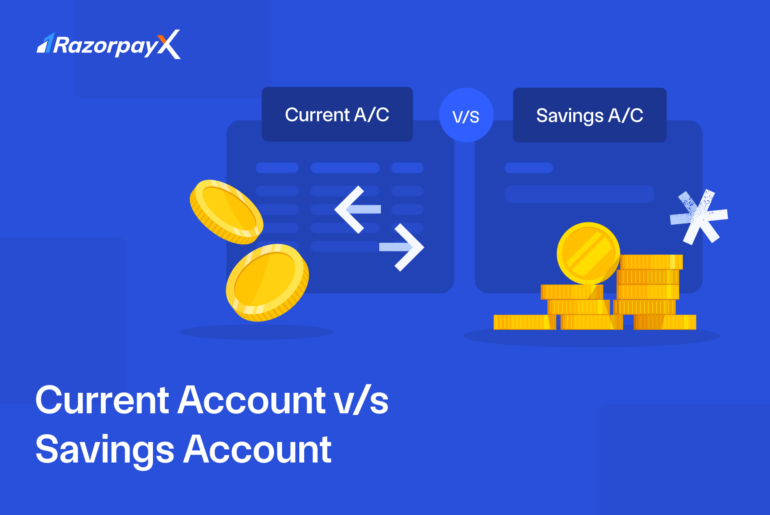Table of Contents
Difference Between Current and Savings Accounts
A savings account is a bank account used to save money and earn interest. A current account is a bank account build to. handle large volumes of transactions daily.
Savings accounts are generally used by individuals who don’t have complex financial needs and do not make huge volumes of transactions. Current accounts are used by businesses or high-net-worth individuals who need to make frequent deposits and withdrawals.
Current accounts are an essential for businesses. They facilitate smooth cash flow and better financial management, resulting in better bottom lines and more profits.
Today, solutions RazorpayX Business Banking+ offer more than just a current account; centralized dashboards for everything from vendor management to payroll, enhanced with automation at all points.
What is a Current Account?
A current account is designed to facilitate frequent financial transactions by traders, business people, and entrepreneurs running their companies, firms, trusts, etc.
Read More: Benefits of Current Account for Business
Current accounts come with a host of specialized featured for businesses like overdraft, loan facilities, corporate credit cards, vendor and payroll management, and more. RazorpayX Business Banking+ is one such banking solution specially designed to simplify the complex financial needs of businesses.
Advantages of a Current Account
What is a Savings Account?
As the name suggests, a savings account is designed to encourage and promote savings. The holder can deposit money conveniently, on which the holder can earn interest. It can be opened by an individual or jointly who intend to build wealth for their short-term and long-term financial goals.
Typically, a savings account offers interest income, and the minimum balance to be maintained is also slightly on the lower side with the facility to issue cheques.. However, the account holders are allowed a limited number of transactions.
Read More: FAQs on Basic Savings Deposit Account
Current Account vs Savings Account
A current account is designed to facilitate frequent business and trade transactions, while a savings account is intended to save and accumulate wealth for future goals.
Current accounts are used majorly by organisations, business owners, companies, etc, while savings accounts are made for salaried people with regular income and short term financial goals.
Current accounts don’t have any restrictions on the maximum number of transactions and, therefore, do not provide any interest earnings to the account holders. Savings accounts allow only a limited number of transactions and so can offer interest-earning linked to a benchmark, such as a bank rate (mostly 4% – 6%).
Minimum balance requirements for current accounts are generally higher than savings accounts since banks have to provide expensive, complex financial services to business, which individuals do not require. Current account holders are also allowed to overdraw funds for short term requirements.
Future of Business Banking
Lately, the collaboration of banks with fintech is stealing the spotlight. Neobanks have been the talk of the town as they are the beautiful product of this collaboration. They leverage their modern digital platform to analyze customer data and make data-driven decisions.
Long, tedious processes involving payments and disbursals can weigh on businesses often but with Neo-banking platforms, money movement and business insights, financial operations can get much simpler.
Today, tech-savvy neo banks swear by the host of services they offer, some of them being – multi-access collaboration, end-to-end automation, real-time notifications and transparency.
Choose the best current account for your business
RazorpayX was born out of the need to deliver the best financial management experience for merchants. It reimagines how businesses manage money flows and simplifies banking for Founders, CXOs Chartered Accountants and finance professionals.
- Banking which Provides end-to-end automation with powerful features
- like Automated Accounting, OTP management, Maker-Checker Flows,
- Corporate Cards with 20X higher limits
- Automated Vendor Payments
- Forex Services
- Payroll – India’s ONLY payroll with Full compliance automation, Employee Insurance management and TDS filing)
Read more:
FAQs
What is Current Account?
A current account is primarily designed to facilitate frequent/regular financial transactions by traders, business people, and entrepreneurs running their companies, firms, trusts, etc.
What is Savings Account?
A savings account is designed to encourage and promote savings. The holder can deposit money conveniently, on which the holder can earn interest.
What is RazorpayX powered Current Account?
RazorpayX was born out of the need to deliver the best business banking experience for merchants. It reimagines how businesses manage money flows and simplifies banking for Founders, CXOs Chartered Accountants and finance professionals.
Is current account better than a savings account?
For businesses, a current account is definitely better than a savings account; but for individuals, a savings account would be more convenient and useful.
What are the disadvantages of current accounts?
Current accounts do not offer any interest income to the account holder. They also demand high MABs.





